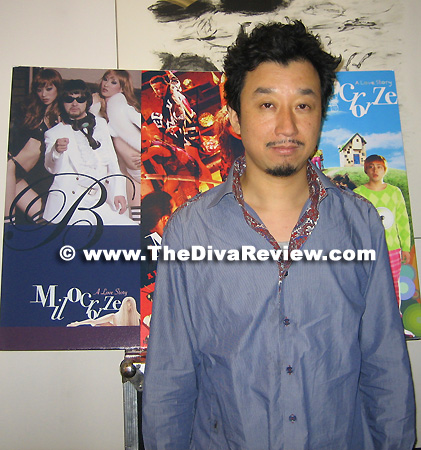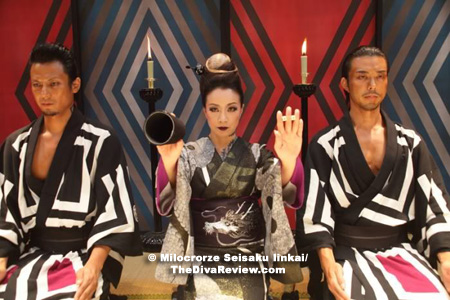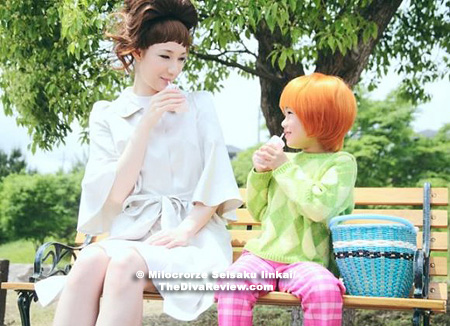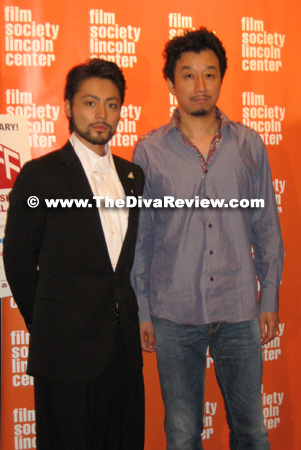
Hey Boys and Girls, temporarily released from the thrall of the New York Asian Film Festival, LMD had a chance to peer into the innovative mind of Yoshimasa Ishibashi, director of the festaís opening night film, the psychedelic, triptacular visual feast Milocrorze: A Love Story. Read on to find out all about art, kimono, grass-eating males and Zen.
Dig it!
Milocrorze: A Love Story
Yoshimasa Ishibashi
 The
Lady Miz Diva: Can you please tell us what the meaning of Milocrorze
is?
The
Lady Miz Diva: Can you please tell us what the meaning of Milocrorze
is?
Yoshimasa Ishibashi: Milocrorze is a word I made up and itís a person that I love. I created it and it also represents the sun. {In}The opening scene thereís a sun scene that starts off. When Tamon gets cut, heís going toward the window and thereís the sun there.
LMD: I think a lot of people will find Bessonís approach to youth counselling a little shocking. Where did the crazy advice he gives to hopeless boys in love come from?
YI: In Japan, in modern times right now, thereís a word - soushokudanshi - that literally translates to ďgrass-eating male.Ē A reverse of ďmeat-eating male,Ē as in non-aggressive, or tends to be on the weak side. So, because men donít have enough power, this message was meant for them.
LMD: The music of Milocrorze is excellent and between this film and in your television sketch show, Vermillion Pleasure Night, you seem to have a great affinity for directing to a certain rhythm. I wondered how important music is to your filmmaking?
YI: For this film there were three people involved in making the music; there was a person who creates music for the movie industry. There was also a person from a jazz band and also myself, and we got together and made the music this film. I wrote Bessonís dance theme. Music is very important to this film. With Vermillion Pleasure Night, the music would come first, then the visuals would follow. Thatís why it is very important that I find the music.
LMD: Will there be a soundtrack?
YI: Yes, Iíd like to.
 LMD:
Can you please talk about the excellent sword fight in the Yakuza
gambling den with Tamon? How many edits are in that scene or is it one
tracking shot?
LMD:
Can you please talk about the excellent sword fight in the Yakuza
gambling den with Tamon? How many edits are in that scene or is it one
tracking shot?
YI: In terms of the set, there was a thirty-meter set that was created, so thatís one set; but in order to shoot it, we made it into sections and divided it into four different scenes, so four different edits.
LMD: And once you had the actors in place, how long did it take to shoot?
YI: Regarding the shooting of the scene, it didnít take very long. But in terms of preparation of the scene, it took a long time. It involved an action director that choreographed the whole thing and all of the people who were involved in it who practised and rehearsed, and they did so for about three months. Then Mr. {Takayuki} Yamada was brought into the picture and introduced with everyone else and then we shot. It went quick, but a lot of preparation.
LMD: The look of the film is so striking and I see so many influences, not only from other filmmakers but artists in painting and photography, as well. I thought of Salvador Dali, Irving Penn, David LaChapelle and a lot of pop art. Are you influenced by artists at all?
YI: Both art and movies, theyíre very important to me and I see a lot of them and I like a lot of artists, but the person I think has influenced me the most is my father. My father is not an artist, but he makes kimonos, the traditional Japanese clothing. I grew up watching my father make the kimonos and thatís why especially in my treatment of artwork -- there tends to be more of flat treatment to art, kimonos are very two-dimensional in terms of treatment and thatís the influence I got from him.
LMD: You mentioned during the premiere Q&A that your wife was the production designer of Milocrorze. What is it like to collaborate with your spouse on a film like this that depends so much on its visuals?
YI: With Vermillion Pleasure Night, my wife, Aki Funabiki, whoís a visual designer, she did a lot of the work on that filming. She also went to the same school as me, we graduated from the same school. Regarding thinking of the visuals, we tend to have similar types of ways of wanting to depict. We had the same results inside of our heads and that made it easier to create.
 LMD:
I loved the way Besson and Tamonís stories interconnect when Besson
drives through Tamonís scene, leaving destruction behind. Was there any
thought to connect Ovreneliís scene in the same way with the other two?
LMD:
I loved the way Besson and Tamonís stories interconnect when Besson
drives through Tamonís scene, leaving destruction behind. Was there any
thought to connect Ovreneliís scene in the same way with the other two?
YI: There was one point in the script that I did had Ovreneli incorporated into it, but I found that because the visuals and the world were so strikingly different, it wasnít fun when it was incorporated into the two worlds, so I found I wanted to keep it separate. But what is connected between them is the cat; heís in the Ovreneli scene and in the Tamon scene; Yuri, the girl that he falls in love with has the cat, too, so thatís a big connection.
LMD: I wondered if the cat would pop up in Bessonís scene?
YI: This is something you would probably have to see again: In the earlier scenes when Ovreneli is commuting and trying to get on the train and he canít get in; on the train platform in the back, thereís Besson. Thereís a picture of him.
LMD: I wondered if the three different characters were three different parts of your personality?
YI: Yes!
LMD: Which one do you feel closest to?
YI: Besson! {Laughs} No, really, everyone.
LMD: When youíve worked for five years on a film like Milocrorze, whatís next?
YI: What I have right now is a movie ten years in the planning. But this one is a lot more challenging and the scale of the film is very large. Weíre planning the fundraising and trying to get the most backers.
 LMD:
What do you hope viewers will take away from Milocrorze: A Love Story?
LMD:
What do you hope viewers will take away from Milocrorze: A Love Story?
YI: Thereís two parts to that answer: One is within the theme of the film; the theme is to fall in love with someone and loving that person. Regardless if youíre male or female, falling in love is a very important part of it. In the movie, thereís a dialog, ďFalling in love is the start of everything.Ē So there should be a time, at least once in your lifetime when you will fall in love to the point where nothing else in the world matters more than just that love.
And the second part is within the last scene with Ovreneli, where it says, ďHe lived well and he had a good death.Ē But within that, there was quite a lot of meaning that was put into it. It may have seemed like it abruptly ended or it didnít matter, but thereís a philosophical thinking about Ku, which is from Buddhism. This concept is based around nothingness. What it says is that no matter how difficult life is, because thereís nothing, itís nothing, so itís basically not difficult.
LMD: Would you please give a message to our readers who may be going to see Milocrorze for the first time during the festival?
YI: This film is quite different from most films in the way it was made. But also in terms of how I want people to experience this, I want people to come and see it as though itís an attraction and almost like a roller-coaster ride. And after leaving the film, to think about or feel the theme of the film later on.
~The Lady Miz Diva
July 2nd, 2011
© 2006-2022 The Diva Review.com
|
|












